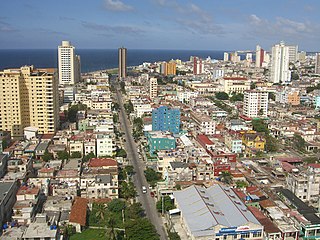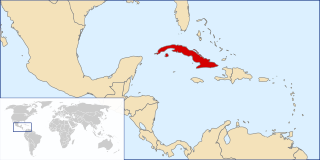
Havana is the capital and largest city of Cuba. The heart of the La Habana Province, Havana is the country's main port and commercial center. It is the most populous city, the largest by area, and the second largest metropolitan area in the Caribbean region. The population in 2002 was 2,137,847 inhabitants, and its area is 728.26 km2 (281.18 sq mi) for the capital city side and 8,475.57 km2 for the metropolitan zone.
Santa Fe or Santa Fé may refer to:

Cuba is an island nation in the Caribbean Sea. It comprises an archipelago of islands centred upon the geographic coordinates 21°3N, 80°00W. Cuba is the principal island, surrounded by four main archipelagos: the Colorados, the Sabana-Camagüey, the Jardines de la Reina and the Canarreos. Cuba's area is 110,860 km2 (42,800 sq mi) including coastal and territorial waters with a land area of 109,820 km2 (42,400 sq mi), which makes it the eighth-largest island country in the world. The main island (Cuba) has 5,746 km (3,570 mi) of coastline and 28.5 km (17.7 mi) of land borders—all figures including the U.S. Navy's Guantanamo Bay Naval Base. Its official area is 109,884 km2 (42,426 sq mi).

La Habana Province, formerly known as Ciudad de La Habana Province, is a province of Cuba that includes the territory of the city of Havana, the Republic's capital. The province's territory is the seat of the superior organs of the state and its provincial administration.

Guanabacoa is a colonial township in eastern Havana, Cuba, and one of the 15 municipalities of the city. It is famous for its historical Santería and is home to the first African Cabildo in Havana. Guanabacoa was briefly the capital of Cuba in 1555 after Havana was attacked by French pirate Jacques de Sores. This gave rise to the Cuban saying “Like putting Havana in Guanabacoa,” which is used to describe trying to fit something too large into a space too small. Guanabacoa was the site of the Battle of Guanabacoa, a skirmish between British and Spanish troops as part of the larger Battle of Havana during the Seven Years' War.

The Castillo de los Tres Reyes del Morro(English: Castle of the Three Kings of Morro), also known as Castillo del Morro(Morro Castle), is a fortress guarding the entrance to the Havana harbor. The design is by the Italian engineer Battista Antonelli (1547–1616). Originally under the control of Spain, the fortress was captured by the British in 1762, returned to Spain under the Treaty of Paris (1763) a year later. The Morro Castle was the main defense in the Havana harbor until La Cabaña was completed in 1774.
Sweetwater or Sweet Water may refer to:
The Cuban League was one of the earliest and longest lasting professional baseball leagues outside the United States, operating in Cuba from 1878 to 1961. The schedule usually operated during the winter months, so the league was sometimes known as the "Cuban Winter League."
Cuban infrastructure is significant and includes: massive Spanish fortifications built in principal ports.

The following is an alphabetical list of topics related to Cuba.

The following outline is provided as an overview of and topical guide to Cuba:
Water privatization in Cuba began in January 2000 when the socialist government of Cuba created a mixed public-private company to manage the water, sewer and stormwater drainage system in 8 of the 15 municipalities that make up the country's capital Havana. The government avoids the term privatization, despite the involvement of two foreign private companies as key partners in the mixed company. The company operates under a 25-year renewable concession contract. It serves 1.25 million inhabitants in the municipalities of Old Havana, Central Havana, Cerro, Plaza de la Revolución, 10 Octubre, La Lisa, Playa, and Marianao, which together are home to 60 percent of Havana's population. The company, called Aguas de la Habana, has a capital of 8 million USD and is owned by the Cuban state through the National Institute for Water Resources (INRH), the Spanish private company Aguas de Barcelona (Agbar) and the Spanish family firm Grupo Martinon. The contract foresees that ultimately the entire population of Havana will be served by the company.

The Captaincy General of Cuba was an administrative district of the Spanish Empire created in 1607 as part of Habsburg Spain attempt to better defend and administer its Caribbean possessions. The reform also established captaincies general in Puerto Rico, Guatemala and Yucatán.

Havana was founded in the sixteenth century displacing Santiago de Cuba as the island's most important city when it became a major port for Atlantic shipping, particularly the Spanish treasure fleet.
Kelvis Ochoa is a Cuban author, composer, and singer.
The American Series was the name given to the exhibition baseball games played between Cuban and American teams in Cuba. Before the Cuban Revolution, American teams would regularly travel to Cuba and play various professional, all-star and/or amateur Cuban teams throughout the country. The series usually took place either in the fall, after the end of the American season, or during spring training before the season began. The first American Series took place in 1879, with then minor league Worcester team going 2–0 against its Cuban opponents.

"Puente" is a latin pop song by Guatemalan recording artist Ricardo Arjona, released on August 9, 2010 as the lead single from his twelfth studio album, Poquita Ropa (2010). The song was written by Arjona, who produced it with longtime collaborators Dan Warner and Lee Levin under their stage name Los Gringos. Two versions of the song were made, one of them being a mixture of salsa, merengue along with Cuban music influences; and the other an acoustic version made with piano and percussion.
The following is a timeline of the history of Havana, Cuba.
The following is a timeline of the history of the city of Matanzas, Cuba.
La Habana is the Spanish name for Havana, the capital of Cuba.









